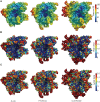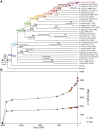Translation: The Universal Structural Core of Life
- PMID: 29788252
- PMCID: PMC6063299
- DOI: 10.1093/molbev/msy101
Translation: The Universal Structural Core of Life
Abstract
The Universal Gene Set of Life (UGSL) is common to genomes of all extant organisms. The UGSL is small, consisting of <100 genes, and is dominated by genes encoding the translation system. Here we extend the search for biological universality to three dimensions. We characterize and quantitate the universality of structure of macromolecules that are common to all of life. We determine that around 90% of prokaryotic ribosomal RNA (rRNA) forms a common core, which is the structural and functional foundation of rRNAs of all cytoplasmic ribosomes. We have established a database, which we call the Sparse and Efficient Representation of the Extant Biology (the SEREB database). This database contains complete and cross-validated rRNA sequences of species chosen, as far as possible, to sparsely and efficiently sample all known phyla. Atomic-resolution structures of ribosomes provide data for structural comparison and validation of sequence-based models. We developed a similarity statistic called pairing adjusted sequence entropy, which characterizes paired nucleotides by their adherence to covariation and unpaired nucleotides by conventional conservation of identity. For canonically paired nucleotides the unit of structure is the nucleotide pair. For unpaired nucleotides, the unit of structure is the nucleotide. By quantitatively defining the common core of rRNA, we systematize the conservation and divergence of the translational system across the tree of life, and can begin to understand the unique evolutionary pressures that cause its universality. We explore the relationship between ribosomal size and diversity, geological time, and organismal complexity.
Figures





References
-
- Anger AM, Armache JP, Berninghausen O, Habeck M, Subklewe M, Wilson DN, Beckmann R.. 2013. Structures of the human and Drosophila 80S ribosome. Nature 4977447:80–85. - PubMed
-
- Auerbach T, Bashan A, Harms J, Schluenzen F, Zarivach R, Bartels H, Agmon I, Kessler M, Pioletti M, Franceschi F, et al. . 2002. Antibiotics Targeting Ribosomes: crystallographic Studies. Curr Drug Targ Infect Disord. 22:169–186. - PubMed
-
- Bachellerie JP, Michot B.. 1989. Evolution of large subunit rrna structure. the 3' terminal domain contains elements of secondary structure specific to major phylogenetic groups. Biochimie 716701–709. - PubMed
Publication types
MeSH terms
Substances
LinkOut - more resources
Full Text Sources
Other Literature Sources
Miscellaneous

